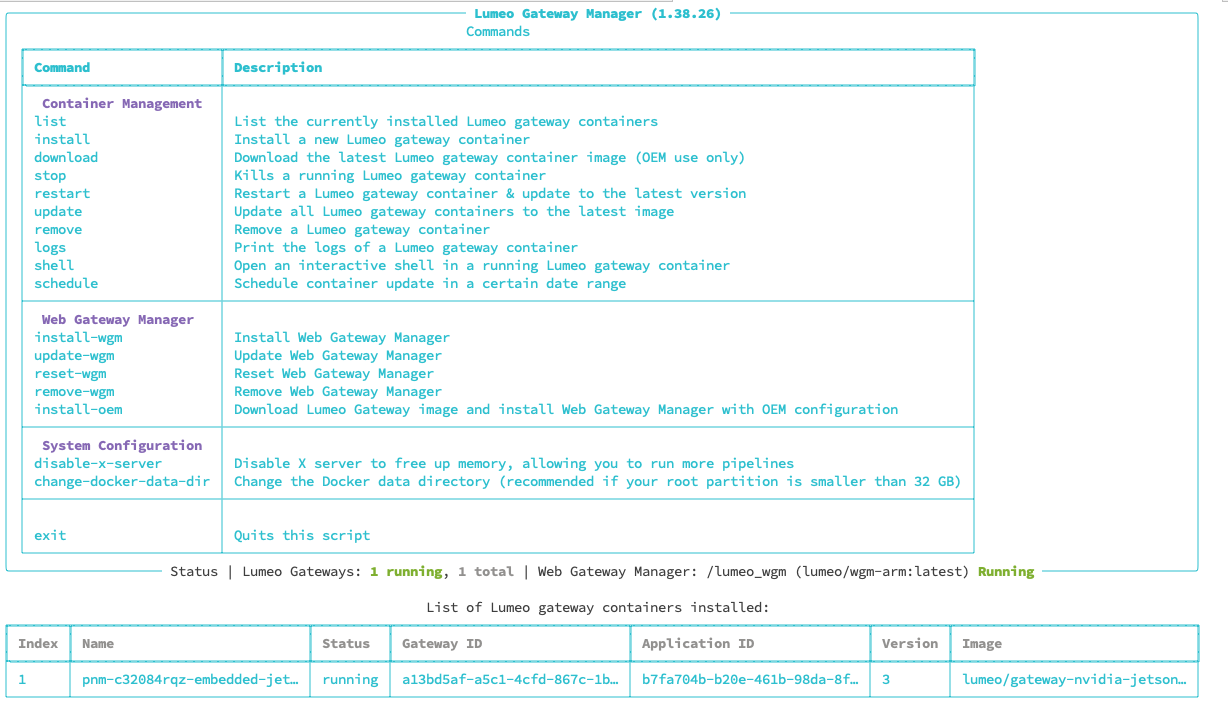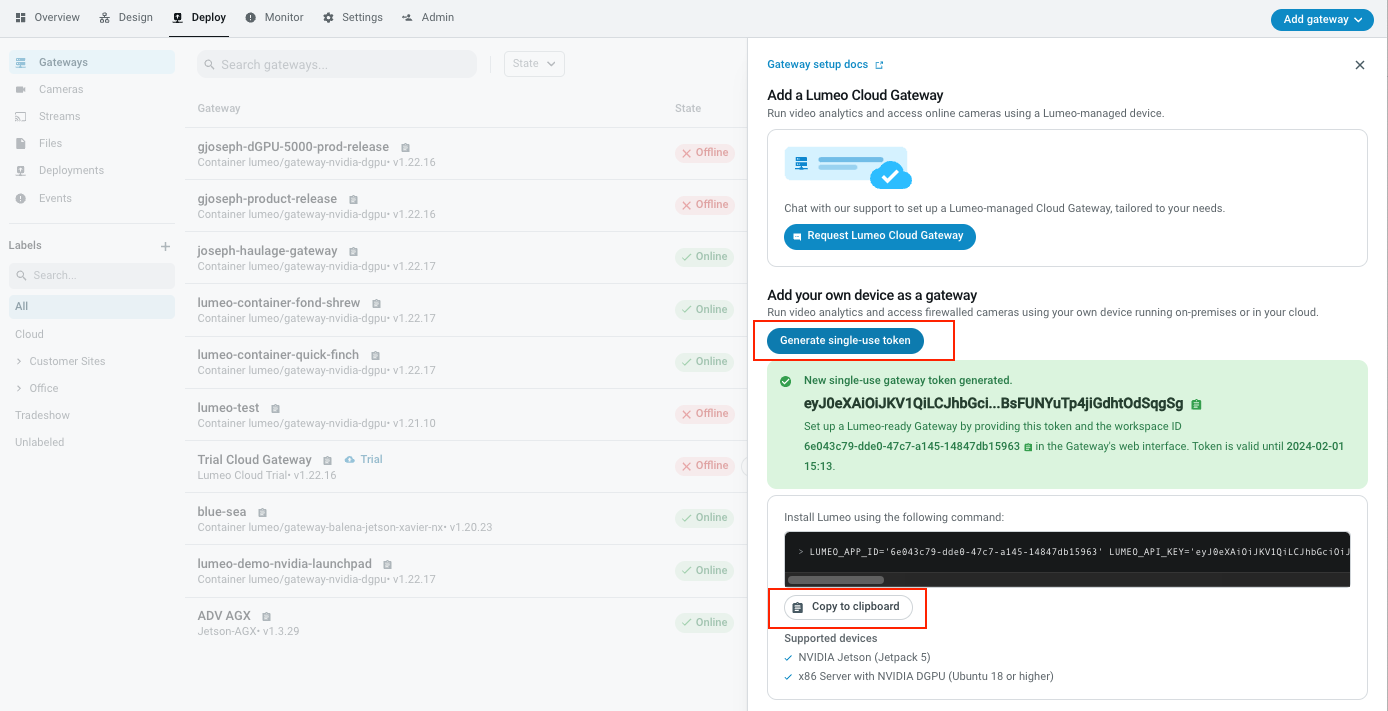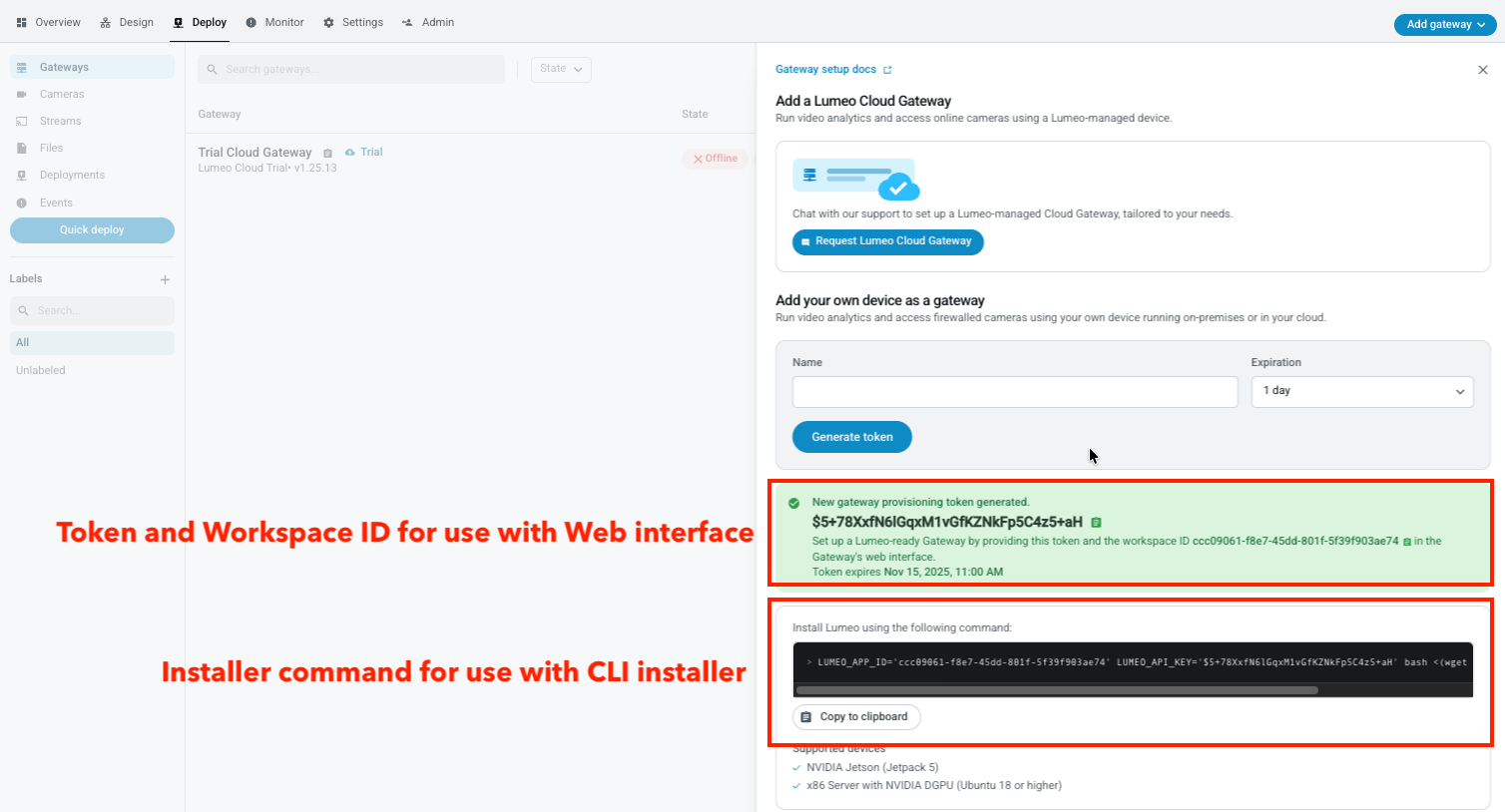Lumeo Gateway Installer
Use the Lumeo gateway installer script to install a Lumeo gateway on a bare-metal machine on-premises or a cloud GPU instance
Follow these instructions if you want to run on a bare-metal box. Supported hardware here : Gateway Hardware
1. Device Preparation
Server with Nvidia GPU
This step is only needed for Discrete GPU setups, not for Jetson devices
If installing on x86 server with Nvidia GPU, before you start, ensure that your device is setup with Ubuntu 22 or later, and the latest Nvidia drivers (version 560 or newer for RTX GPUs and version 535 or newer for Datacenter GPUs).
$ sudo ubuntu-drivers list
nvidia-driver-535-server-open, (kernel modules provided by linux-modules-nvidia-535-server-open-generic-hwe-22.04)
nvidia-driver-545-open, (kernel modules provided by nvidia-dkms-545-open)
nvidia-driver-570-server, (kernel modules provided by linux-modules-nvidia-570-server-generic-hwe-22.04)
nvidia-driver-570-server-open, (kernel modules provided by linux-modules-nvidia-570-server-open-generic-hwe-22.04)
nvidia-driver-535-open, (kernel modules provided by linux-modules-nvidia-535-open-generic-hwe-22.04)
nvidia-driver-535-server, (kernel modules provided by linux-modules-nvidia-535-server-generic-hwe-22.04)
nvidia-driver-565-open, (kernel modules provided by nvidia-dkms-565-open)
nvidia-driver-550-open, (kernel modules provided by linux-modules-nvidia-550-open-generic-hwe-22.04)
nvidia-driver-560, (kernel modules provided by nvidia-dkms-560)
nvidia-driver-580-open, (kernel modules provided by linux-modules-nvidia-580-open-generic-hwe-22.04)
nvidia-driver-580-server, (kernel modules provided by linux-modules-nvidia-580-server-generic-hwe-22.04)
nvidia-driver-570-open, (kernel modules provided by linux-modules-nvidia-570-open-generic-hwe-22.04)
nvidia-driver-580, (kernel modules provided by linux-modules-nvidia-580-generic-hwe-22.04)
nvidia-driver-545, (kernel modules provided by nvidia-dkms-545)
nvidia-driver-570, (kernel modules provided by linux-modules-nvidia-570-generic-hwe-22.04)
nvidia-driver-580-server-open, (kernel modules provided by linux-modules-nvidia-580-server-open-generic-hwe-22.04)
nvidia-driver-470, (kernel modules provided by nvidia-dkms-470)
nvidia-driver-470-server, (kernel modules provided by nvidia-dkms-470-server)
nvidia-driver-535, (kernel modules provided by linux-modules-nvidia-535-generic-hwe-22.04)
nvidia-driver-550, (kernel modules provided by linux-modules-nvidia-550-generic-hwe-22.04)
nvidia-driver-565, (kernel modules provided by nvidia-dkms-565)
$ sudo apt-get update && sudo apt-get install -y nvidia-driver-580Remember to reboot after installing the driver, and verify by running nvidia-smi on a terminal prompt.
Nvidia Jetson Orin
Ensure that the Jetson device has Jetpack 6.2.1 (preferable). Lumeo can also be installed on Jetpack 5.x but some newer features require Jetpack 6.x.
2. Interactive Install
Set up a new Gateway by running the following commands on it and following the installer prompts. You have 2 modes to choose from:
- The Engine only option below installs just the Lumeo gateway engine, but requires you to link the Gateway to your Lumeo account using interactive login.
- The option with the Web interface installs it with a web interface to manage it. You can then use the web interface after setting up the machine to link it to your Lumeo account.
We recommend using the Engine-only install for public clouds, and installing with the Web interface for on-prem devices. The Web interface makes management and maintenance easier.
Engine only.
bash <(wget -qO- https://link.lumeo.com/setup)This command can also be found in Console under Gateways → Add Gateway. The installer offers you a bunch of options to optimize your installation in the interactive model. Installing the Gateway using this installer will also set it up to auto update whenever a new Gateway version is released.
After running the installer command once, you can invoke the Lumeo gateway manager / installer in the future with a simple lumeo-gateway-manager command.

Key commands (run lumeo-gateway-managerfor a full list) :
| Command | Description |
|---|---|
| list | List the currently installed Lumeo gateway containers |
| install | Install a new Lumeo gateway container |
| remove | Remove a Lumeo gateway container |
| install-wgm | Install Web Gateway Manager (web interface for managing Lumeo gateways) |
To make it easy, head to Deploy -> Add Gateway to generate a gateway provisioning token and grab a prefilled installer command you can copy and run on your gateway.

Gateway installer command
Engine with Web Interface
Use this command to install Lumeo Gateway engine with a web interface.
bash <(wget -qO- https://link.lumeo.com/setup) install-oemAfter running the installer, follow next steps on Lumeo-Ready Gateways to link the Gateway to your Lumeo account.
3. Unattended Install
Gateway installer supports the following environment variables to allow for bulk, unattended installations:
Env Variable | Description | Notes |
|---|---|---|
| Specify the Application ID to connect this gateway to. See section to find your Application ID. | |
| Provide the API Key for the specific Application you want to connect this gateway to. See section to find your API Key. | |
| Specify the name used for the Gateway & container | |
| Schedule Lumeo container update in a certain date range. See | |
| Specify this env variable to provision a Gateway using the default settings. Note: |
Examples: Install and provision gateway to a specific Application Id.
LUMEO_APP_ID='app_id' LUMEO_API_KEY='api_key' bash <(wget -qO- https://link.lumeo.com/setup)LUMEO_APP_ID='app_id' LUMEO_API_KEY='api_key' NO_PROMPT=1 bash <(wget -qO- https://link.lumeo.com/setup) installYou can generate this installation URL by going to Deploy -> Gateways -> Create Gateway button in Lumeo console.

4. Update Schedule
Lumeo Gateway ensures seamless updates to keep your system running smoothly and securely. You can customize the update schedule according to your preferences. Here are the available string formats and examples for defining the update schedule:
Time Range Updates: Define a time window during which updates can occur. This is particularly useful for ensuring updates happen during off-peak hours.
Example: monday 9:00am - 11:00am
Example: monday 9:00am - wednesday 5:00pm
Example: friday 5:00pm - monday 9:00am
Example: tuesday 2:45pm
Weekend & weekdays Updates: Schedule updates specifically for weekends or weekdays.
Example: weekdays 8:00pm
Example: weekends 10:00am
Note: When the end time is not specified for a certain format, it will default to 11:59pm. For example, wednesday 3:15pm translates internally to wednesday 3:15pm - 11:59pm. Similarly, weekdays 3:15pm and weekends 3:15pm follow the same convention.
Note: The minimum time interval for updates is 2 hours.
You can configure, edit or remove the update schedule from your Gateway settings by re-running the setup script and selecting the option schedule, or use the LUMEO_UPDATE_SCHEDULE environment variable during installation.
Ensure that your update schedule aligns with your operational requirements and consider factors such as peak usage times and system downtime.
Updated 26 days ago
